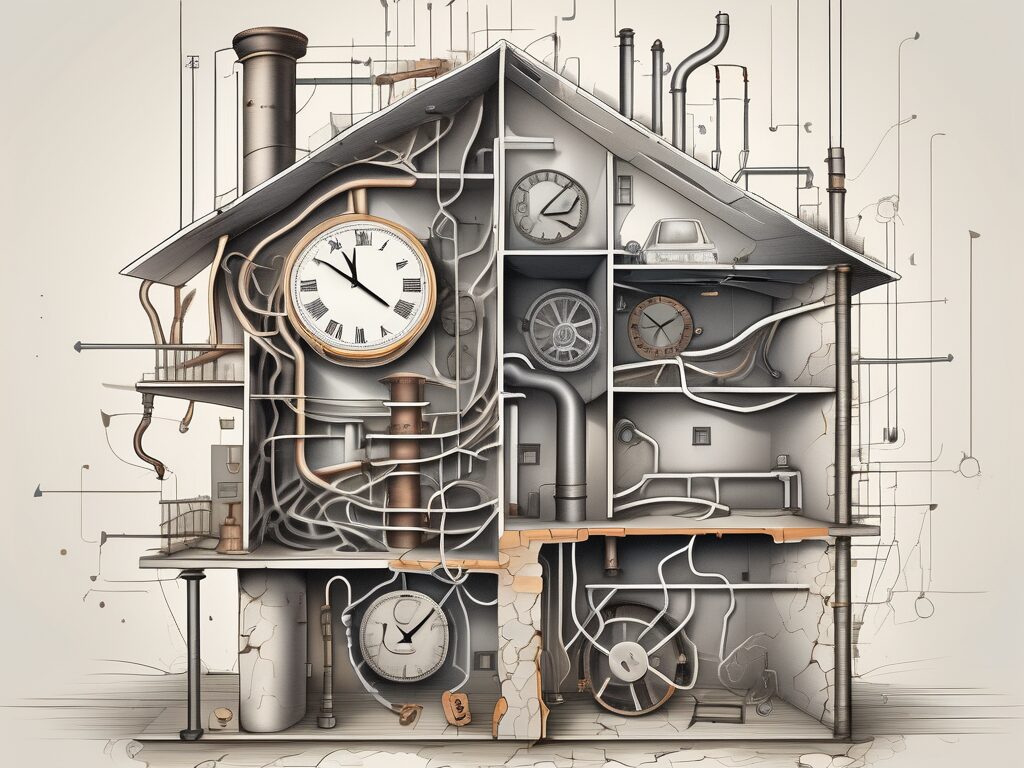
Agent A-Team or Solo Superhero? Finding the Right Real Estate Partner for Your Selling Journey in Wildwood Florida
When it comes to selling your home in Wildwood, Florida,…
January 29, 2024
Replumbing your house is a significant project that requires careful planning and consideration. Understanding the factors that affect the cost of replumbing is essential in order to make informed decisions. In this ultimate guide, we will explore the various cost factors associated with replumbing, recognize the signs that indicate a need for replumbing, and discuss the pipe materials that you should watch out for.
Replumbing costs can vary widely depending on several factors. Home size, pipe material, and labor costs all play a role in determining the total expense of the project.
When it comes to replumbing, the size of your home is a major factor that can significantly impact the cost. Larger homes require more plumbing materials, longer installation times, and increased labor costs. This is because more pipes and fixtures are needed to accommodate the size of the property. Additionally, the number of fixtures, such as sinks, toilets, and showers, will also impact the overall cost. Each fixture requires its own set of pipes and connections, adding to the complexity and expense of the replumbing project.
Another crucial aspect that affects the cost of replumbing is the type of pipe material used in your current plumbing system. Older homes may have outdated pipe materials that are prone to leaks and corrosion, such as lead or galvanized steel. These materials not only pose potential health risks but can also result in frequent repairs and maintenance. Replacing these pipes with modern, durable materials like copper or PEX can increase the upfront cost of the project. However, it is important to consider the long-term benefits. These modern materials are more resistant to corrosion and leaks, providing you with a reliable and efficient plumbing system that may reduce future repair costs.
When planning for a replumbing project, it is essential to factor in labor costs. The complexity of the job, the number of plumbers required, and the duration of the project will all impact the final cost. Hiring experienced and reputable plumbers may come with a higher price tag, but their expertise can ensure a successful and efficient replumbing process. It is worth investing in skilled professionals who can handle the intricacies of the project, ensuring that the plumbing system is installed correctly and functions optimally.
It is important to note that while replumbing can be a significant investment, it is also an opportunity to improve the overall functionality and efficiency of your home’s plumbing system. By considering factors such as home size, pipe material, and labor costs, you can make informed decisions that will not only meet your immediate plumbing needs but also provide long-term benefits and peace of mind.
While cost is an important factor to consider, it is equally crucial to recognize the signs that indicate a need for replumbing. Ignoring these signs can lead to more significant issues and potentially higher costs in the long run.
Replumbing is a process that involves replacing the old plumbing system in a home with new pipes and fixtures. It is a necessary step to ensure the proper functioning of the plumbing system and to avoid potential problems such as leaks, bursts, and low water pressure.
Here are some key signs that indicate your home may need replumbing:
Older homes, especially those built before the 1960s, may have outdated plumbing systems that are prone to leaks, bursts, and other plumbing issues. If your home is several decades old, it is advisable to assess the condition of your pipes and consider replumbing as a preventative measure.
When assessing the age of your plumbing system, it is important to consider the materials used in the pipes. Older homes often have pipes made of galvanized steel or cast iron, which are more prone to corrosion and deterioration over time.
Replumbing your home will not only ensure the reliability of your plumbing system but also increase the value of your property. Potential buyers are often hesitant to purchase homes with outdated plumbing systems, so investing in replumbing can be a wise decision if you plan to sell your home in the future.
One of the most obvious signs that your home needs replumbing is rusty water. If you notice brownish or discolored water coming out of your taps or see rust stains in your sinks and toilets, it is a clear indication that your pipes are deteriorating and need immediate attention.
Rusty water can be caused by the corrosion of the pipes, which allows rust particles to mix with the water supply. Not only is rusty water unappealing, but it can also pose health risks if consumed or used for cooking and cleaning.
Replumbing your home will eliminate the issue of rusty water, ensuring that you have clean and clear water flowing through your taps. It will also prevent further corrosion of the pipes, saving you from potential leaks and water damage.
If you find yourself constantly dealing with pipe leaks and repairs, it may be time to consider replumbing. Multiple leaks are often a symptom of deteriorating pipes, and patching them up will only provide temporary solutions. Replumbing will provide a long-lasting fix and save you from the continuous hassle and costs of repairing faulty pipes.
Recurring pipe leaks can cause significant damage to your home, including water stains, mold growth, and structural issues. By replumbing your home, you can eliminate the risk of future leaks and ensure the integrity of your plumbing system.
When replumbing, it is important to hire a professional plumber who has experience in replacing pipes and fixtures. They will be able to assess the extent of the damage and recommend the best course of action to ensure a reliable and efficient plumbing system.
Another warning sign that your house may require replumbing is low water pressure. If you are experiencing weak water flow in various fixtures, it could indicate blockages, pipe corrosion, or other plumbing issues that replumbing can address. Replumbing will help restore proper water pressure and ensure an efficient water supply throughout your home.
Low water pressure can be frustrating, especially when it affects everyday tasks such as showering, washing dishes, or doing laundry. It can also indicate underlying problems in the plumbing system that need to be addressed.
Replumbing your home will involve replacing the old pipes with new ones that are free from blockages and corrosion. This will allow for better water flow and improved water pressure, enhancing your overall comfort and convenience.
Visible corrosion on your pipes should never be ignored. Rust, flaking, or disintegrating pipes are signs of severe deterioration and can lead to leaks and potential water damage in your home. Replumbing should be done urgently to prevent further deterioration and costlier repairs.
Corrosion can occur due to various factors, including age, water quality, and the materials used in the pipes. If you notice any signs of corrosion, such as discoloration, rough texture, or visible damage on the pipes, it is crucial to take immediate action.
Replumbing your home will involve removing the corroded pipes and replacing them with new ones made of durable and corrosion-resistant materials. This will not only eliminate the risk of leaks and water damage but also improve the overall performance and longevity of your plumbing system.
In conclusion, recognizing the signs that indicate a need for replumbing is essential for maintaining the functionality and integrity of your home’s plumbing system. By addressing these signs promptly and investing in replumbing, you can avoid costly repairs, ensure a reliable water supply, and enhance the value of your property.
Not all pipe materials are created equal, and there are some materials that you should be cautious about if they are present in your current plumbing system. Lead pipes, polybutylene pipes, and galvanized steel pipes are among the materials that can pose serious problems and require replumbing.
Lead pipes were commonly used before the 1950s and pose significant health risks. Lead can leach into your water supply, resulting in lead poisoning. This can have severe consequences, especially for children and pregnant women. The ingestion of lead-contaminated water can lead to developmental delays, learning disabilities, and even behavioral problems. It is crucial to replace lead pipes with safer alternatives, such as copper or PEX, to ensure the health and safety of your household.
When replumbing your home to remove lead pipes, it is important to consider the scope of the project. This may involve assessing the entire plumbing system, including hidden pipes behind walls and under floors. It is advisable to consult with a professional plumber who specializes in lead pipe replacement to ensure a thorough and effective replumbing process.
Polybutylene pipes were popular from the late 1970s to the mid-1990s due to their low cost and easy installation. However, they are notorious for their susceptibility to breakage and leaks. The material used in polybutylene pipes can become brittle over time, leading to cracks and fractures. This can result in water damage to your home, including structural damage, mold growth, and costly repairs.
Replumbing your home to replace polybutylene pipes is highly recommended to avoid potential water damage and the associated expenses. When replumbing, it is essential to choose a more durable and reliable pipe material, such as copper or CPVC (Chlorinated Polyvinyl Chloride), to ensure the long-term integrity of your plumbing system.
Galvanized steel pipes were commonly used in older homes due to their durability and strength. However, over time, these pipes are prone to rust, corrosion, and blockages. The accumulation of rust and corrosion inside the pipes can lead to reduced water flow, leaks, and even pipe bursts.
Replumbing your home to replace galvanized steel pipes is essential to ensure the long-term safety and functionality of your plumbing system. By replacing them with materials like copper or PEX, you can avoid the issues associated with galvanized steel pipes and enjoy a reliable and efficient plumbing system.
When replumbing your home, it is important to consider the overall impact on your daily life. The replumbing process may require temporary disruptions to your water supply, and you may need to make alternative arrangements during the replumbing period. It is advisable to consult with a professional plumber who can guide you through the replumbing process and minimize any inconvenience.
In conclusion, replumbing your house is a significant investment that requires careful consideration of various cost factors. Understanding the impact of home size, pipe material, and labor costs can help you make informed decisions. Additionally, recognizing the signs that indicate a need for replumbing, such as an aging home, rusty water, recurring leaks, low water pressure, and visible corrosion, is vital for preventing further damage and potential health risks. Lastly, being aware of the dangers associated with certain pipe materials, such as lead, polybutylene, and galvanized steel, will guide you in prioritizing replumbing for long-term safety and peace of mind.

If you want the Richr team to help you save thousands on your home just book a call.
 Book a call
Book a call